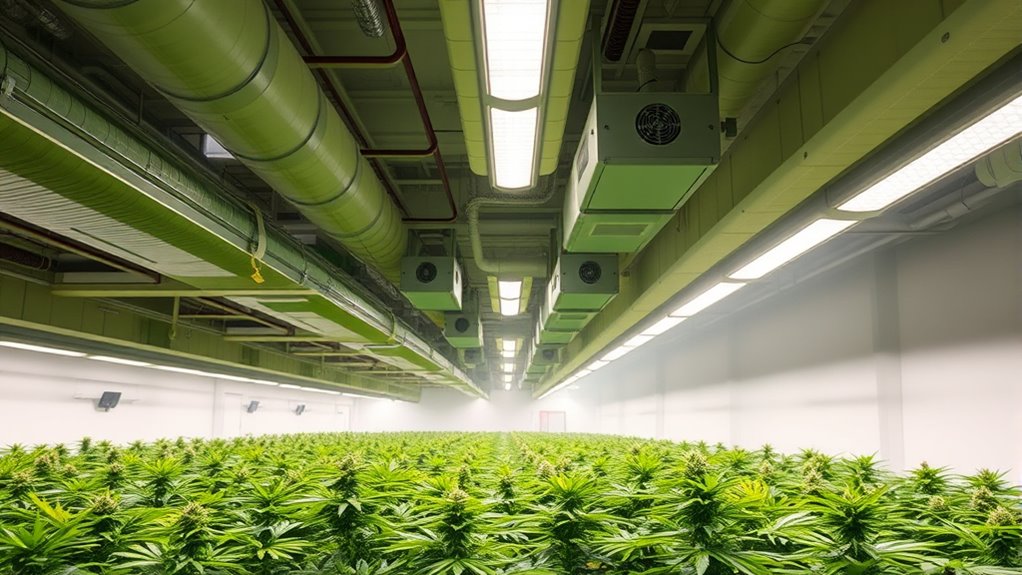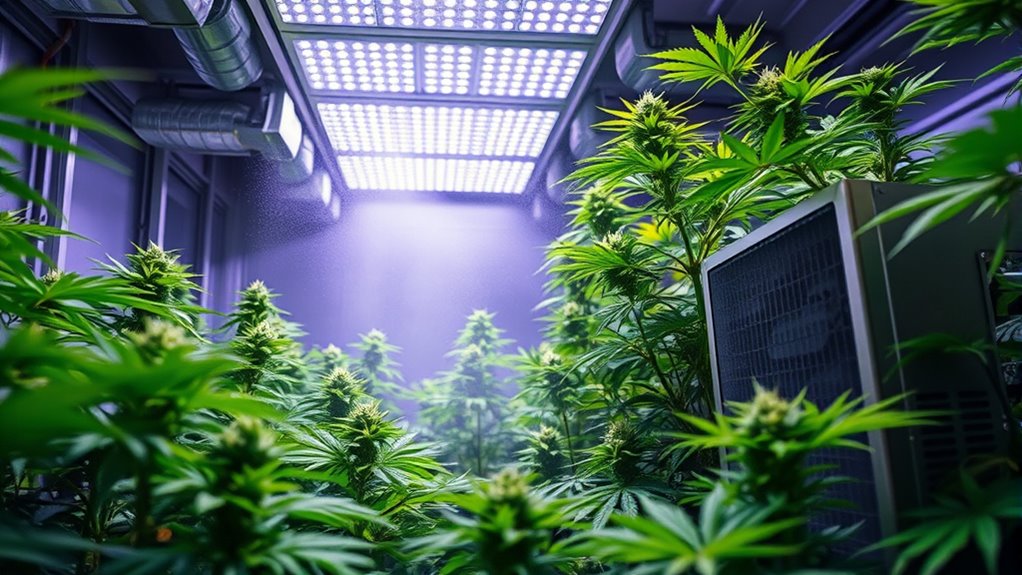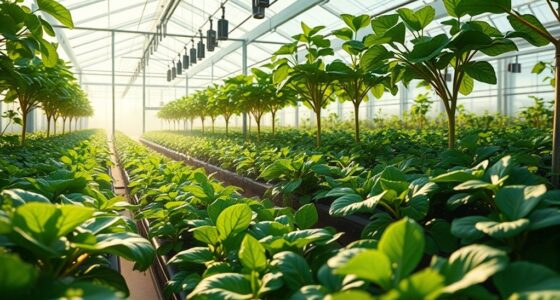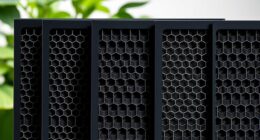To control odors and mold in your cannabis grow facility, make certain you have effective air filtration and ventilation systems in place. Use HEPA filters to capture mold spores and activated carbon filters to eliminate odors. Regularly maintain and replace filters, monitor humidity levels between 40-60%, and optimize airflow to prevent stagnant air. Proper environmental management keeps your grow healthy and discreet. Keep going to discover how advanced IAQ strategies can keep your operation thriving.
Key Takeaways
- Effective air filtration, including HEPA and activated carbon filters, removes airborne mold spores and odors, ensuring a clean environment.
- Regular maintenance and timely filter replacement sustain filtration efficiency and prevent mold growth and odor issues.
- Proper environmental controls, such as humidity between 40-60%, reduce mold risk and improve air quality.
- Optimized ventilation and airflow management eliminate stagnant air pockets that promote mold and odor buildup.
- Continuous IAQ monitoring helps detect mold spores and airborne contaminants early, enabling proactive odor and mold control.

Maintaining essential indoor air quality (IAQ) is critical for the success of cannabis grow facilities, as it directly impacts plant health, yield, and overall safety. When it comes to optimizing IAQ, effective air filtration plays a pivotal role. By filtering out airborne contaminants, you prevent the buildup of dust, pollen, and other particles that can compromise your plants’ health. High-quality air filtration systems also help control odors, which is indispensable for maintaining discreet operations and complying with local regulations. When odors are managed properly, your facility remains compliant and avoids attracting unwanted attention. Furthermore, good air filtration isn’t just about scent control; it’s fundamental for mold mitigation. Mold spores are ubiquitous in the environment, but if they find a hospitable environment inside your grow space—high humidity, stagnant air, and organic material—they can quickly multiply and cause serious problems. Proper filtration, combined with diligent environmental control, ensures these spores are removed before they settle and grow.
You should invest in systems designed specifically for the unique needs of cannabis cultivation. HEPA filters, for example, are excellent at capturing fine particles, including mold spores, while activated carbon filters help eliminate odors. These filters, when integrated into your ventilation system, work continuously to maintain a clean, odor-free environment. Regular maintenance of your air filtration units is essential; filters need replacement or cleaning to keep them functioning at peak efficiency. Neglecting this can lead to reduced filtration performance, allowing mold spores or odors to slip through. Additionally, controlling humidity levels is critical for mold mitigation. Keeping humidity between 40-60% discourages mold growth, and proper airflow helps prevent stagnant air pockets where mold spores can settle. Incorporating advanced filtration technologies can further enhance your system’s ability to remove airborne pests and pathogens, safeguarding your crop’s health. Another key aspect is ensuring your ventilation system is properly sealed and balanced. Proper airflow reduces dead zones where mold spores and stale air can accumulate. You also want to monitor your IAQ regularly with sensors that detect mold spores and air quality parameters. This proactive approach helps you catch issues early before they develop into bigger problems. When your air filtration system is working effectively, and your environmental controls are in place, you create a safer, healthier space for your plants to thrive. You’ll see improved yields, fewer mold-related setbacks, and a more discreet operation thanks to efficient odor control. By prioritizing air filtration and mold mitigation, you set your cannabis grow facility up for sustained success and compliance.
Frequently Asked Questions
How Often Should Air Filters Be Replaced in Grow Facilities?
You should replace your air filters every 1 to 3 months, depending on their air filter lifespan and your ventilation scheduling. Regularly check for buildup, reduced airflow, or odors, which indicate it’s time for a change. Proper filter maintenance guarantees ideal odor and mold control. Adjust your schedule based on grow conditions, and don’t wait too long, as clogged filters can compromise air quality and grow health.
What Specific Mold Prevention Strategies Are Most Effective?
You should implement mold prevention strategies like using mold-resistant materials in your grow facility and applying biological controls, such as beneficial fungi or bacteria, to suppress mold growth. Regularly inspect your environment for excess humidity and improve ventilation to keep moisture levels low. Keeping surfaces clean and dry, combined with these strategies, helps prevent mold effectively and maintains ideal indoor air quality for your cannabis cultivation.
Can Natural Ventilation Effectively Control Odors in Large Grows?
Think of natural ventilation like a gentle breeze clearing fog from a window—it can help with odor dispersion, but its effectiveness varies. In large grows, natural ventilation alone often struggles to control odors consistently because it depends on weather and wind conditions. While it may reduce some odors, for reliable odor control, you’ll need supplemental systems like exhaust fans or activated carbon filters to guarantee effective ventilation and odor management.
How Does Humidity Impact Mold Growth in Cannabis Facilities?
Humidity levels directly impact mold growth in your cannabis facility. If humidity is too high, mold thrives, risking crop health. By maintaining ideal humidity regulation, you can prevent mold development and safeguard your plants. Use dehumidifiers and proper ventilation to keep moisture in check. Consistent humidity control is essential for mold prevention, ensuring a healthy, mold-free environment that promotes robust plant growth and maximizes yields.
Are There Eco-Friendly Odor Control Options Available?
Yes, eco-friendly odor control options are available. You can use plant-based deodorizers, which effectively neutralize odors without harmful chemicals. Green cleaning practices also help maintain a healthy environment by using biodegradable and non-toxic products. These options are safe for your plants and staff, while reducing your ecological footprint. Incorporating plant-based deodorizers and green cleaning into your routine guarantees you control odors sustainably and responsibly.
Conclusion
By maintaining proper IAQ, you’re building an invisible shield around your cannabis grow, like a sturdy glass dome that keeps odors and mold at bay. Think of your facility as a lush garden, where fresh air flows like gentle breezes, nurturing healthy plants while blocking unwanted pests. With vigilant odor and mold control, you’re guiding your operation toward a thriving, pristine oasis—where quality blooms, and your success blossoms effortlessly.









